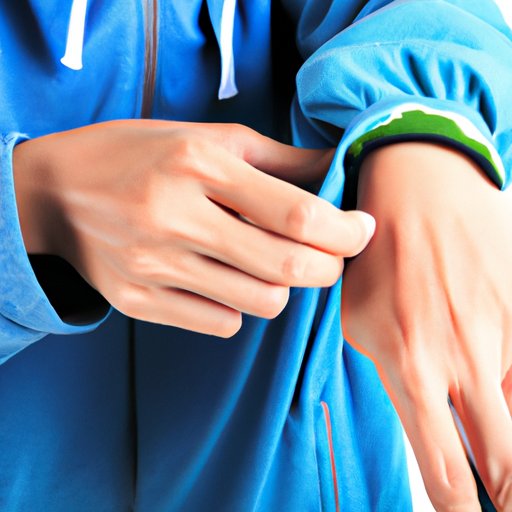
I. Introduction
Have you ever found yourself itching all over during or after exercise? If so, you’re not alone. Many people experience exercise-induced itching, which can be not only uncomfortable but also distressing. In this article, we’ll explore the science behind it, common causes and remedies, how to choose workout clothing for sensitive skin, warning signs, and symptoms that indicate a need for medical attention.
II. The Science Behind It: Why Does Exercise Cause Itching in Some People?
Exercise increases blood flow, raises body temperature and stimulates sweat glands to produce sweat which leads to itching in some people. When sweat evaporates, it can leave behind salt crystals that irritate the skin, leading to itching and irritation. This type of itching, called exercise-induced urticaria, is an allergic reaction that can also cause hives or skin rashes. Histamines, chemicals produced by the body’s immune system, are responsible for these hives, rashes, and itching sensations. In some cases, heat is a contributing factor, as people who are prone to heat rashes or sunburn may be more likely to develop exercise-related itching.
III. Is Your Itchy Skin Ruining Your Workout? Here’s What You Can Do
If you experience exercise-induced itching, there are steps you can take to reduce or prevent it. To start, choose clothing made of moisture-wicking, breathable fabrics that allow your skin to breathe. If you have sensitive skin, also make sure to wash your workout clothes regularly and avoid using any harsh detergents or fabric softeners. Additionally, apply a moisturizer or barrier cream to problem-prone areas before exercising to prevent irritation.
IV. Understanding Exercise-Induced Itching: Common Causes and Remedies
Common causes of exercise-induced itching include medication, stress, a family history of eczema, sensitive skin, hay fever, and high levels of histamines in the body. A natural remedy for itching is oatmeal, which has soothing properties and can be mixed with water to create a paste that can be applied directly to the skin. Over-the-counter treatments, such as anti-itch creams and lotions containing hydrocortisone or calamine, can also provide relief. If you experience recurring or severe symptoms, it’s important to speak with your doctor or a dermatologist, who can suggest additional remedies or medications to manage the itching.
V. The Connection Between Blood Flow and Itching During Exercise
Exercise increases blood flow to all parts of the body, including the skin. However, when blood vessels dilate, they create more space for histamines to be released, which can lead to itching. Other factors that can impact blood flow, such as dehydration or a drop in blood pressure caused by sudden changes in body position during exercise, have also been identified as causes of itching.
VI. Do Certain Fabrics Worsen the Itch? Tips to Choose Workout Clothes for Sensitive Skin
Certain fabrics, particularly synthetic materials, can contribute to itching and irritation during exercise. Fabrics like polyester or lycra can trap sweat and heat, leading to skin irritation and itching. Opt for moisture-wicking and breathable materials, such as cotton or bamboo, which allow the skin to breathe and remain cool during exercise. Loose-fitting clothing can also provide relief by reducing friction and allowing air to circulate around the body.
VII. When to Seek Medical Help for Exercise-Induced Itching: Warning Signs and Symptoms
While exercise-induced itching is not always a cause for concern, it’s important to recognize red flags that indicate a need for medical attention. These can include the appearance of new symptoms or the intensification of existing ones, such as wheezing, difficulty breathing or swallowing, or swelling in the face or throat. These could be signs of anaphylaxis, a severe and potentially life-threatening allergic reaction that requires immediate medical intervention. Additionally, if you experience recurring or severe itching or notice swelling, redness, or any other symptoms that affect the quality of your daily life, consult a doctor or dermatologist.
VIII. Conclusion
In conclusion, exercise-induced itching can be an uncomfortable and frustrating issue, but there are several steps you can take to alleviate it. From wearing the right workout clothes to adjusting your exercise routine, there are many remedies that can help. It’s essential to understand the underlying causes of your itching, and to speak with your doctor or dermatologist if you notice any warning signs or experience a worsening of existing symptoms. By addressing exercise-induced itching, you can enjoy a more comfortable and rewarding workout experience.





